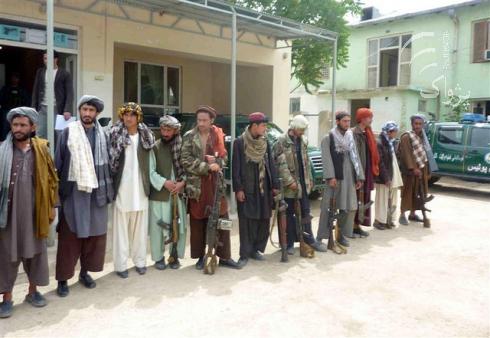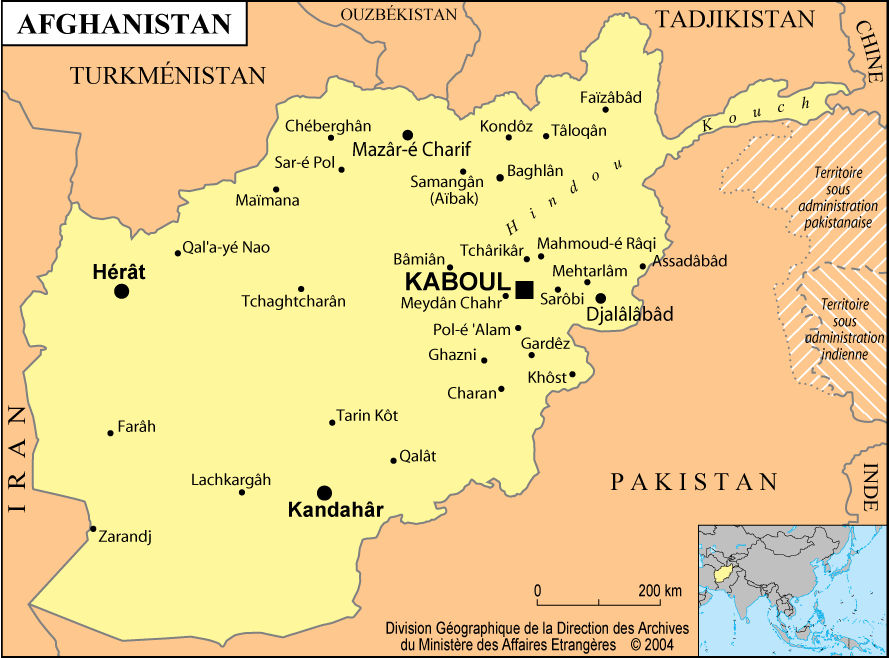source diplomatie.gouv.fr
10/18/2011 Keith Mallon - defenceiq.com
Keith Mallon is Defence IQ's Strategy and Content Director.
The 10 year anniversary of NATO’s intervention in Afghanistan has prompted widespread comment on the progress of that conflict. Striking in the the recent coverage is not only the profound sense of pessimism from many commentators, but also the attention paid to the insurgency’s component factions.
There is no shortage of opinion on Afghanistan, understanding the protagonists’ own perspectives on the conflict offers many insights into how the war is being fought. A recent RUSI article observed that all sides seem to think that they’re winning; a worrying prospect for the gravely damaged peace process when everyone approaches the negotiations from a perceived position of strength.
Insurgency and the Taliban
Looking at the insurgents’main groupings individually, a broad degree of variance can be seen in their fortunes Although the term “Taliban” is widely misappropriated and misunderstood by the media, the Pashtun fighters of Helmand and Kandahar are the Mullah Omar led group who are most closely associated with the term. Militarily, they have been subject to a tremendous assault over the last ten years, even more so since President Obama surged US troops into the region.
Whilst still maintaining an outward position of defiance, ISAF recently intercepted a communication from the “inner shura” declaring that the proposed summer offensive against NATO forces had “utterly failed”. Original NATO estimates of the Helmand and Kandahar insurgency revolved around a simplistic three tier model of the insurgent, ranging from the ideologically-committed zealot to the hired gun.

Source: Pajhwok Afghan News
Despite clear variances within the level of commitment to the Taliban cause amongst fighters, informed observers (like James Ferguson) have detailed lengthy caveats to this view. In their opinion, assumption of this basic structure leads to a false understanding of the depth of opposition NATO forces face from a population implacably opposed to foreign and armed occupation. Nevertheless the sheer scale of the military campaign has suppressed the group’s capacity to stage attacks and foreign troops. Its negotiating position may be weakened. Their media pronouncements are then viewed with suspicion, but this may be to confuse the real intended audience; the insurgency has proven to be remarkably adept at manipulating its message to the civilian population whose distrust of the Karzai government and the notorious Afghan National Police runs deep.
The Haqqani Network and Foreign Support
Whilst the story of Helmand and Kandahar is one of tentative progress, the eastern regions have witnessed an explosion of violence as the relative safe haven of Pakistan provides a never-ending logistics chain of weapons and, crucially, feet on the ground. Most active here is the Haqqani network who received widespread attention after Admiral Mike Mullen suggested in late September that they were supported by Pakistani intelligence. The defiance of this group is well justified. The network, which operates a very loose command structure over the multiple tribal fighters that carry out attacks and crime under its umbrella, has scored a number of spectacular hits against the coalition and Afghan forces. These include the major incidents witnessed at the Intercontinental Hotel and against both US and UK facilities in Kabul, mocking the US ambassador’s assertion that the biggest problem in the city was traffic.
The long time expert on Afghanistan, Michael Semple has observed that the Haqqanis have much to gain from the continuation of conflict within Afghanistan. Although Jalaluddin Haqqani is both a Pashtun and veteran of the mujahideen fight against the Soviets, his interests in the conflict go beyond the establishment of a Sharia state and the expulsion of foreigners. Funded through substantial criminal enterprise and the supply of ammonium nitrate (the key ingredient in IEDs), they profit greatly from the war. Recently they were accused of being behind the assassination of former Afghan President Burhanuddin Rabbani, although they later issued a denial of their involvement in his killing. This may be true, or it may be an attempt to reduce the pressure on their Pakistani colleagues, smarting both from the death of Osama bin Laden and subsequent US scrutiny on their links to terror.
Their media operations are slick with videos of gory violence interspersed with pointed attacks against the Karzai government’s many weak flanks. Such coordinated activity indicates not only their strength, but their importance to any final settlement in Afghanistan. Their vocal contempt for Karzai highlights how little prospect there is for peace whilst he remains in power.
The Other Afghanistan Players
Whilst the West’s war in Afghanistan may be 10 years old, an increasingly held view is that NATO is just a late entrant to the long-running Afghan civil war. Another key player in the insurgency is Gulbuddin Hekmatyar, founder and leader of the Hezb-e Islami group. Known to be a ruthless opportunist, the former Afghan Prime Minister is playing a long game. His presence in the trenches alongside the Haqqanis and Quetta shura is evidence of his strategic calculation as to who the main players in Afghanistan’s future are.
Crucially again, the Karzai government doesn’t feature strongly, although talks have been held in the past. Hekmatyar though has been making highly public outreaches to US forces, going so far as to publish his own peace plan in 2010 and again recently, offering the chance for the US to leave Afghanistan “honourably”. Undoubtedly, any such peace would involve a prime position for Hekmatyar. His continual public positioning feeds into his efforts to secure greater power and influence.

Chief Justice Shinwani from the Supreme Court of Afghanistan (right) administers the Oath of Office for the Presidential Inauguration to Afghanistan President Hamid Karzai at the Presidential
Palace in Kabul, Afghanistan, Dec 7, 2004. Defense Dept. photo by U.S. Air Force Master Sgt. James M. Bowman
Source: U.S. Department of Defense
The Karzai government, meanwhile, continues to be dogged by accusations of corruption, and ineffectiveness. The leak of the UK Government’s official attitude to Karzai was embarrassing not only as a security breach, but also by revealing the lack of confidence held in Karzai by London and assuredly Washington too. The deficit of perceived legitimacy in Karzai among Afghanis of course undermines the administration. The assassination of ex-President Rabbani and the reaction of many within Karzai’s camp (notably Amrullah Saleh) again shows how precarious any peace process is.
Many are opposed to dealing with the Quetta headquartered Taliban, especially the northern based Tajiks, long time poltical rivals of Karzai. However recent speeches in India have shown his main concern to be Pakistan, who he blames for running a proxy war in his country. This cosying up to India, a nation that many Afghans view with fondness, causes significant fear in Islamabad.
Although doing business with India may potentially lead to more positive outcomes in Kabul, the government still displays ample reasons for misgivings, not least as it recently refused to conduct a probe into corruption cases. Noteworthy however, are the political moves being made by both regional governors and Afghan parliamentary members as they begin to see beyond the Karzai years. Many powerful tribal leaders are represented here and they will have an important say in any deal on Afghanistan’s future.
ISAF: Departures and Diplomacy
ISAF’s declared departure date of 2014 ensures that it seizes upon any signs of progress with enthusiasm. Data published in October 2011 shows a reduction in Taliban attacks, but is countered by UN statistics illustrating a rapidly deteriorating security picture.
Recent books such as Frank Ledwidge’s “Losing Small Wars” have heaped criticism upon the conduct of the campaign in Afghanistan, views that were echoed by former ISAF commander General Stanley McChrystal. His remarks that NATO forces were only “a little better than” halfway to securing a future for Afghanistan will be especially damaging given the timetable for withdrawal in 2014.

Source: ISAF Headquarters Public Affairs Office from Kabul, Afghanistan
Against this backdrop, some parties suggest that ISAF underestimates the scale challenge they’re facing and that evidence the strategy is working is thin on the ground. Extensive effort has been expended on information operations within Afghanistan, but the extent to which this has succeeded in countering the insurgency’s narrative is not clear. However US Secretary of State Hillary Clinton’s remarks that the US would be open to a peace deal with groups such as the Haqqanis indicate a renewed pragmatism in ISAF’s dealings with the insurgency.
The Pakistan Problem
President Karzai’s view that Pakistan is much to blame for the violence of Afghanistan is not exclusive to him. Ever since the deterioration in relations with the US, marked by bin Laden’s death, Pakistan has come in for immense criticism over its role in the insurgency. This support is not as straightforward as one might think, with strains between the ISI and the insurgent network being frequent. Pakistan’s response has been to angrily and very publicly reject any accusations of supporting terror and to run to the welcoming arm of the Chinese.
This behavior betrays the true situation facing Pakistan. Despite being able to create severe mischief in the region, the country does not have a strong strategic hand. Domestic instability, long-standing paranoia over neighbor India’s intent and an angry US government combine to raise major challenges for the government. Influence of the situation in Afghanistan is the main bargaining chip Pakistan still holds. Pakistan finds itself in a sticky situation as multiple factions within its borders will pose security threats depending upon the eventual outcome.
India and Economic Interest
India role in Afghanistan doesn’t receive much international media coverage. But that is to ignore the huge economic interest India has in Afghanistan, not to mention the security implications of a major war that involves Pakistan. Large numbers of Indian workers are involved in major construction projects and they have been targeted for attacks by insurgents. India’s timidity to date in becoming involved in any aspect of security in Afghanistan is based upon a calculation of strategic interest. However, the visit of President Karzai shows how Delhi is developing its response to the conflict and adopting a more assertive stance in the region. The prospect of a heavily ISI- influenced Pakistan that would have increased capacity to launch terror attacks into India is a sufficiently frightening prospect for her government to consider the array of options very carefully indeed.
The Western Press
A final group worthy of review within the Afghanistan drama is that of the Western press. As mentioned, recent anniversary coverage of the war was its overwhelming despondency and pessimism about the chances for peace. Optimistic appraisals of the war were not to be found and most opinion and analysis was overwhelmingly negative. This is in sharp contrast to the polarized debate that took place during the bloody years of the Iraq insurgency where fault lines between pro and anti war supporters were clearly visible.
Even such normally trenchant outlets such as Fox News have been remarkably sober in their analysis of the war. There is some debate in evidence over whether or not the Afghanistan mission could continue, but even here, a strange accord exists, with most agreeing that the real threat to the West lies in Pakistan. Is this pessimism the product of group thinking? Or is it that the situation in Afghanistan has become severe enough for a common ground to surface in its reportage? One curious point that has emerged is a report from the Afghanistan Analysts’ Network where some US and UK newspapers are challenged over their willing acceptance of ISAF press releases as fact. Given the centrality of NATO’s “capture and kill” strategy in weakening the insurgency’s resolve, blindly swallowing the official account would, if true, be a serious charge indeed.
As NATO defence budgets are slashed and the rationale for continuing in Afghanistan is more openly questioned, it’s noteworthy that the most bullish media narratives are emanating from the insurgent groups. That in itself is an ominous sign.





